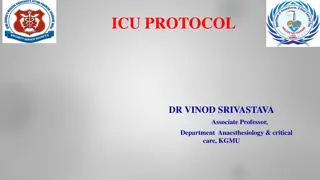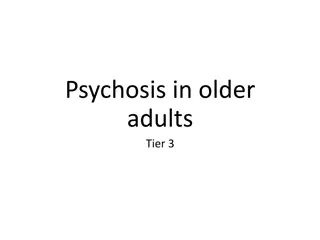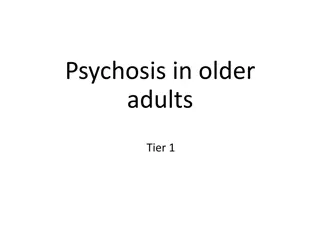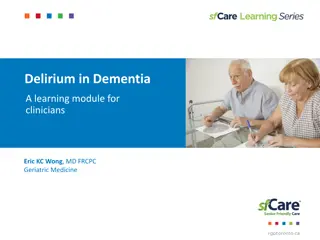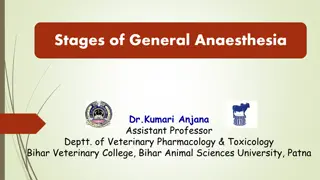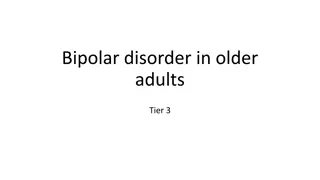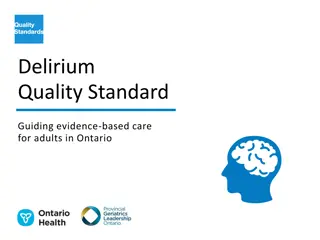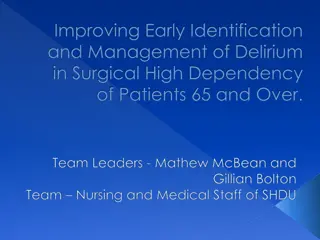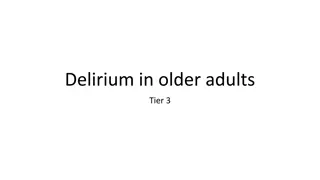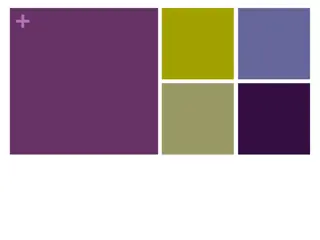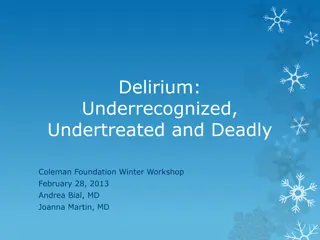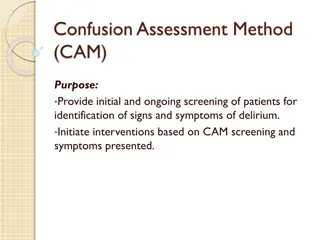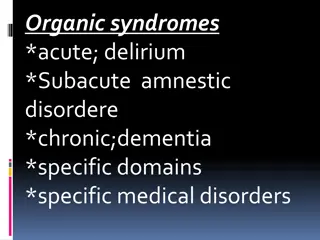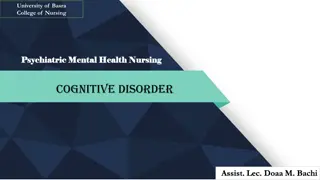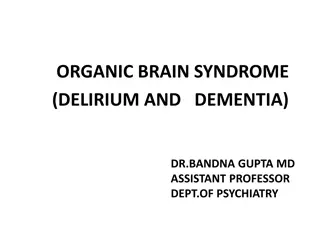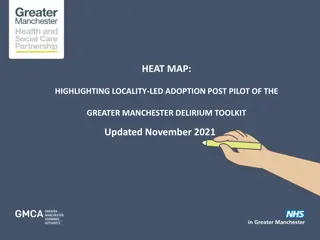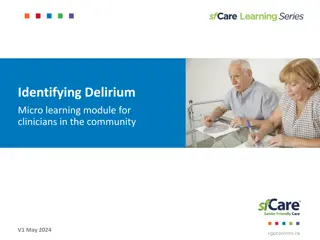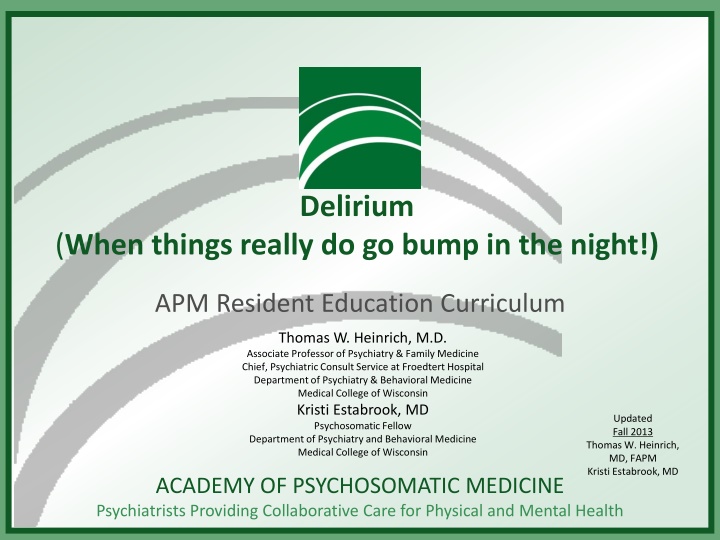
Delirium: Symptoms, Criteria, and Prevalence
Delirium is a state of altered mental status characterized by disturbances in attention and cognition. Learn about the DSM-5 criteria, classification, motoric subtypes, synonyms, and prevalence of delirium in various patient populations.
Download Presentation

Please find below an Image/Link to download the presentation.
The content on the website is provided AS IS for your information and personal use only. It may not be sold, licensed, or shared on other websites without obtaining consent from the author. If you encounter any issues during the download, it is possible that the publisher has removed the file from their server.
You are allowed to download the files provided on this website for personal or commercial use, subject to the condition that they are used lawfully. All files are the property of their respective owners.
The content on the website is provided AS IS for your information and personal use only. It may not be sold, licensed, or shared on other websites without obtaining consent from the author.
E N D
Presentation Transcript
Delirium (When things really do go bump in the night!) APM Resident Education Curriculum Thomas W. Heinrich, M.D. Associate Professor of Psychiatry & Family Medicine Chief, Psychiatric Consult Service at Froedtert Hospital Department of Psychiatry & Behavioral Medicine Medical College of Wisconsin Kristi Estabrook, MD Psychosomatic Fellow Department of Psychiatry and Behavioral Medicine Medical College of Wisconsin Updated Fall 2013 Thomas W. Heinrich, MD, FAPM Kristi Estabrook, MD ACADEMY OF PSYCHOSOMATIC MEDICINE Psychiatrists Providing Collaborative Care for Physical and Mental Health
DSM 5 Criteria Disturbance in attention Disturbance develops over a short period of time, is distinctly different from baseline and tends to fluctuate Has an additional disturbance in cognition (e.g., memory deficit, disorientation, language, visuospatial ability, or perception) Not accounted for by dementia Caused by a general medical condition 2 Academy Of Psychosomatic Medicine
DSM 5 Criteria Classification of delirium Delirium due to another medical condition Substance intoxication delirium Substance withdrawal delirium Delirium due to multiple etiologies Medication induced delirium Delirium not otherwise specified 3 Academy Of Psychosomatic Medicine
DSM 5 Criteria Further Specifiers Time Acute : Hours/Days Persistent: Weeks/Months Level of activity Hyperactive Hypoactive Mixed level of activity Academy Of Psychosomatic Medicine
Synonyms for Delirium Acute confusional state Encephalopathy Acute brain failure ICU psychosis Altered mental status Acute reversible psychosis Academy Of Psychosomatic Medicine
Motoric Subtypes of Delirium Hypoactive Decreased activity Lethargy Apathy Hyperactive Increased activity Delusions Hyperalert Mixed Academy Of Psychosomatic Medicine
Prevalence Emergency department patients: 10-15% Hospitalized medically ill: 10-30% Hospitalized elderly patients: 10-40% Intensive care unit patients: 30% Hospitalized cancer patients: 25% Post operative patients: 30-40% Post CABG: 51% Post repair of fractured hip: 50% Terminally ill patients: 80% Adapted from Brown and Boyle 2002 Academy Of Psychosomatic Medicine
Recognition However, delirium is commonly unrecognized ER patients: 17% identified (Lewis et al 1995) Hospitalized patients: 33% identified (Rockwell & Cosway 1994) Delirium should always be considered when there is an acute or subacute deterioration in behavior, cognition or function Academy Of Psychosomatic Medicine
Consequences Increased Mortality 3-year mortality for hospitalized elderly with index episode of delirium was 75% vs. 51% for non-delirious controls(Curyto et al 2001) No difference in pre-hospital levels of depression, global cognitive performance, physical functioning or medical comorbidity Delirious patients experienced an adjusted risk of death of almost 2.0 compared to nondelirious controls (Inouye et al 1998) Even after controlling for age, gender, ADL, dementia and APACHE II Increased Morbidity Poor functional recovery Possible future cognitive decline Increased risk of complications Increased nursing home placement Increased costs and LOS Academy Of Psychosomatic Medicine
Risk Factors (Partial List) Elderly Decreased cholinergic activity Vascular changes Pharmacokinetic changes CNS disorders Dementia represents one of the greatest risk factors Multiple medications Burn patients Low serum albumin Drug dependency Academy Of Psychosomatic Medicine
A Case of an Angry 82 Year-Old 82 year-old male with a history of probable Alzheimer s disease, CAD, and DM has been admitted from a nursing home for worsening confusion and behavioral problems. The nursing personnel at the NH report that the symptoms have become progressively worse since he began having problems sleeping 3 days ago. Attempts to examine the patient upon arrival to the floor are complicated by his attempts, as he eloquently states, to Knock you on your ass! Review of the medical records from the ED report similar behavior and reports of seeing things. He was given lorazepam prior to the CT of his head. He slept through the CT, which only showed atrophy and white matter disease, but is now quite awake and potentially dangerous. Academy Of Psychosomatic Medicine
Clinical Features Temporal course Abrupt or acute onset Within days Fluctuation in symptom severity Waxing and waning Worse at night May result in diagnostic uncertainty Academy Of Psychosomatic Medicine
Clinical Features Diffuse cognitive impairment Attentional deficits Reduced ability to focus, sustain or shift attention Clouding of consciousness Memory impairment Long and short term Disorientation Commonly to time and place Rarely to person Executive dysfunction Academy Of Psychosomatic Medicine
Clinical Features Thought disturbances Disorganized Language disturbances Word finding problems Dysgraphia Perceptual disturbances Misperceptions Hallucinations (Visual >> Auditory) Academy Of Psychosomatic Medicine
Clinical Features Psychomotor abnormalities Hyper, hypo or mixed Sleep-wake cycle disturbance Insomnia Frequent napping or drowsiness during the day Delusions Usually paranoid and not systematized Affective lability Neurologic abnormalities Academy Of Psychosomatic Medicine
Recognition Delirium Dementia Depression Onset Abrupt Slow and insidious Usually stable Variable Daily Course Length Consciousness Alertness Fluctuating Usually stable Hours to weeks Years Variable Reduced Clear Clear Increased or decreased Increased or decreased Impaired Usually normal Normal Activity Variable Variable Attention Orientation Usually normal Usually normal Impaired Impaired Normal 16
Pathophysiology Acetylcholine The cholinergic system is involved in: Attention Arousal Memory Decreased cholinergic activity produces deficits in: Information processing Arousal Attention and ability to focus Various metabolic insults, thiamine deficiency and anticholinergic medications all can produce delirium through a decrease in cholinergic activity Academy Of Psychosomatic Medicine
Pathophysiology Dopamine An excess of dopamine may be a source of the agitation, delusions and psychosis in delirious patients There is an inverse relationship between dopamine and acetylcholine levels Dopaminergic agents may induce delirium Dopamine antagonists are an effective treatment for delirium Academy Of Psychosomatic Medicine
Pathophysiology Other suggested neurotransmitters GABA Increased in hepatic encephalopathy Decreased in alcohol withdrawal Histamine Serotonin Cytokines Implicated in delirium resulting from tissue destruction, infection or inflammatory causes Academy Of Psychosomatic Medicine
The Angry 82 Year-Old (continued) Since the patient is presently being slightly less than cooperative with your attempts to gather a history you collect collateral information Although he has some baseline memory problems his current state represents an acute change His behavior tends to be worse at night when he does not sleep and is more confused and sometimes suspicious The nurse reports that he is doing better now that she has given him some ice cream, she wonders if you would like to complete your history now You identify the fact the patient is disorientated to place and time He is easily distracted by events in the hall and can not concentrate on your questions When he attempts to answer your questions he has trouble finding the right words and staying on question Academy Of Psychosomatic Medicine
Etiology Identification of underlying cause is paramount to treatment Common causes General medical conditions Medications Substance intoxication Substance withdrawal Multiple etiologies Academy Of Psychosomatic Medicine
Etiology Intoxication with drugs Many drugs implicated especially anticholinergic agents, NSAIDs, antiparkinsonism agents, antimicrobials, steroids, opiates, sedative- hypnotics, and illicit drugs Withdrawal syndromes Alcohol, sedative-hypnotics, and barbiturates Metabolic causes Hepatic, renal or pulmonary insufficiency Endocrinopathies such as hypothyroidism, hyperthyroidism, hypopituitarism or hypoglycemia Disorders of fluid and electrolyte balance Academy Of Psychosomatic Medicine
Life Threatening Causes of Delirium (Caplan and Stern, 2008) W: Wernicke's encephalopathy; withdrawl (alcohol or BZDs) H: Hypoglycemia; hypoxia; hypoperfusion of CNS; hypertensive crisis I: Infections; intracranial processes M: Metabolic derangements; Meningitis P: Poisons S: Seizures Academy Of Psychosomatic Medicine
Etiology Infections Sepsis, meningitis, pneumonia, and urinary tract infection Head trauma Subdural hematoma Epilepsy Neoplastic disease CNS metastasis or limbic encephalopathy Vascular disorders Cerebrovascular Cardiovascular Academy Of Psychosomatic Medicine
Assessment Recognition History Establish course of mental status changes Talk to family or caregivers Recent medication change(s) Symptoms of medical illness Review medical record Review anesthesia record if post-op Onset of delirium is best clue to causality Academy Of Psychosomatic Medicine
Assessment Physical and neurologic examination Vitals and focused physical exam Mental status Observe for behavioral signs Cognitive tests Folstein Mini Mental State Exam Clock drawing task Digit span Months backwards Academy Of Psychosomatic Medicine
Assessment Basic laboratory test Blood chemistries Complete blood count Hepatic function panel TSH B12 and folate RPR Serum drug levels Urinalysis and collection for culture Additional tests ECG Cardiac enzymes HIV Chest X-ray ANA Lumbar puncture 27 Academy Of Psychosomatic Medicine
Assessment Electroencephalogram Helpful to confirm the diagnosis Usually generalized slowing Low voltage fast activity in alcohol or sedative-hypnotic withdrawal Structural Neuroimaging Focal neurologic signs History or concern of head trauma No clear cause of delirium found Academy Of Psychosomatic Medicine
The Angry 82 Year-Old (continued) With your diagnosis of delirium you set out to determine potential etiologies of this dangerous condition Review of the NH records reveal Recent discontinuation of donepezil (Aricept) secondary to worsening dementia Diphenhydramine (Benadryl) was started 3 days ago to help him get some sleep Chronic digoxin therapy Chronic urinary incontinence without mention of dysuria Most recent labs (CBC and BMP performed 6 months ago) were grossly normal Academy Of Psychosomatic Medicine
The Angry 82 Year-Old (continued) Examination of the patient The patient is afebrile with normal vitals Heart, lungs and abdomen are benign Neurologically he displays some intermittent myoclonic jerks and a nonfluent aphasia Mental status/state examination reveals Impaired attention Digit span of only 3 FMMSE score of 10 (score of 21 one year ago) Orientated X 3/10 0/3 at 5 minutes Poor repetition and 3 step-command Unable to spell WORLD backwards Impaired drawing Academy Of Psychosomatic Medicine
The Angry 82 Year-Old (continued) Laboratory evaluation of the patient CBC, BMP are all normal LFTs are normal except for a low albumin TSH, B12, Folate, and RPR are also normal Digoxin level is supratherapeutic Cardiac enzymes are normal U/A is positive for nitrates and leukocyte esterase Reflex culture is pending CT of head revealed global atrophy and chronic microvascular disease EKG only shows rate controlled atrial fibrillation Academy Of Psychosomatic Medicine
Treatment Two important aspects Identify and reverse the reason(s) for the delirium Reduce psychiatric or behavioral symptoms of delirium Environmental manipulation Medication Academy Of Psychosomatic Medicine
The Angry 82 Year-Old (continued) Potential etiologies identified Medications Digoxin toxicity coupled with its anticholinergic properties Diphenhydramine s anticholinergic properties Recent discontinuation of the cholinesterase inhibitor donepezil Infection UTI Malnutrition Academy Of Psychosomatic Medicine
Treatment Environmental manipulations Aims Cognitively non-demanding Limit the risk of harm to self and/or others Types Avoid interruption of sleep Room close to nursing station Sitter Clocks and calendar Adequate lighting Sensory aids Academy Of Psychosomatic Medicine
Treatment Major classes of medications utilized Antipsychotics Typical Atypical Cholinesterase inhibitors Benzodiazepines Academy Of Psychosomatic Medicine
Treatment Typical Antipsychotics Low potency Not recommended High potency - Haloperidol the gold standard Virtually no anticholinergic properties Little risk of hypotension Does not suppress respiration Can be given IV Not FDA approved Little cardiotoxicity Concern of QTc prolongation Fast acting N.B. IV haloperidol precipitates with phenytoin and heparin Academy Of Psychosomatic Medicine
Treatment Haloperidol starting dose Elderly Mild agitation: 0.5mg Moderate agitation: 1mg Severe agitation: 2mg Young adult Mild agitation: 1-2mg Moderate agitation: 2-5mg Severe agitation: 5-10mg Dose may be repeated at regular intervals until patient is calm Max dose: 10mg/d for elderly & 20mg/d for youth Academy Of Psychosomatic Medicine
Treatment Haloperidol side effects Extrapyramidal reactions (EPS) Very low rate of EPS with IV administration (Tesar GE et al 1985) Coadministration with lorazepam may further lower the incidence (Menza MA et al 1988) Hypotension Usually related to volume depletion Academy Of Psychosomatic Medicine
Treatment Haloperidol side effects QTc prolongation Rare Recommendations Pretreatment determination of QTc Avoid other medications that may prolong QTc Monitor potassium and magnesium Monitor QTc during treatment Stop haloperidol if QTc > 500 msec or if baseline QTc increases by more than 60 msec Academy Of Psychosomatic Medicine
Treatment Atypical antipsychotics Increasingly more randomized, prospective studies evaluating efficacy Use partially supported on the basis of clinical experience, case reports and small case studies Theoretical lower risk of extrapyramidal side effects Acute dystonic reactions Drug-induced parkinsonism Akathisia Continued risk of QTc prolongation Academy Of Psychosomatic Medicine
Treatment Atypical antipsychotics (continued) Quetiapine (Seroquel) Better than placebo in randomized control study Only oral formulation Dosage Starting dose 12.5mg-25mg qhs and titrate to effect Can also use 12.5mg-25mg q6h prn Aripiprazole (Abilify) No randomized prospective studies available Multiple formulations Oral tablet, oral tablet (disintegrating), oral solution, and intramuscular Dosage ??? Academy Of Psychosomatic Medicine
Treatment Atypical antipsychotic (continued) Risperidone (Risperdal) Has been found in small randomized trials to match Haldol, Olanzapine in efficacy Multiple formulations Oral tablet, oral tablet (disintegrating), oral solution, and long-acting decanoate Dosage Starting dose 0.25mg-0.5mg/day scheduled Can also use 0.25-0.5mg q6h prn agitation Usually no more than 2mg/day required Ziprasidone (Geodon) No randomized prospective studies available Intramuscular route available Dosage ??? Academy Of Psychosomatic Medicine
Treatment Atypical antipsychotics (continued) Olanzapine (Zyprexa and Zydis) Small prospective, randomized-control studies show efficacy matching Haldol Multiple formulations Oral tablet, oral tablet (disintegrating), oral solution, and intramuscular Dosage Starting dose 2.5mg-5mg qhs Can use 2.5-5mg 6h prn agitation Usually no more than 10mg/day required Academy Of Psychosomatic Medicine
Treatment Cholinesterase inhibitors Physostigmine Diagnostic tool for anticholinergic toxicity Rarely needed for treatment Dangers Benzodiazepines Most appropriate for alcohol or sedative-hypnotic withdrawal Potential adjunct to high potency antipsychotics Academy Of Psychosomatic Medicine
Treatment Dexmedetomidine Selective alpha-2 agonist Approved for short-term use (<24 hours) in patients initially receiving mechanical ventilation Has been shown to help with ventilator weaning (Ricker et al 2009; Reade et al 2009) Not well studied as an agent for long-term administration Side effects Bradycardia Hypotension (especially with hypovolemia) Sedation Academy Of Psychosomatic Medicine
Screening and Prevention More focus recently on better detection and prevention of delirium UK NICE guidelines for delirium have evidence based recommendations Use CAM or CAM-ICU for delirium screening 13 specific guidelines to prevent delirium Entire guideline available Academy Of Psychosomatic Medicine
Confusion Assessment Method (CAM) -A tool to screen for delirium Features 1. Acute change in mental status with a fluctuating course 2. Inattention 3. Disorganized thinking 4. Altered level of consciousness Scoring the CAM Diagnosis of delirium requires the presence of features 1 and 2 and either 3 or 4 Academy Of Psychosomatic Medicine
Delirium _____________________________ Prevention Cognitive impairment or disorientation Dehydration or constipation Hypoxia Immobility or limited mobility Infection Multiple medications Pain Poor nutrition Sensory impairment Sleep disturbance Academy Of Psychosomatic Medicine
Delirium _____________________________ Prevention Cognitive impairment or disorientation Provide appropriate lighting and clear signage. A clock and a calendar should also be easily visible to the person at risk Reorientate the person by explaining where they are, who they are, and what your role is Introduce cognitively stimulating activities Facilitate regular visits from family and friends Hypoxia Assess for hypoxia and optimize oxygen saturation if necessary Academy Of Psychosomatic Medicine
Delirium _____________________________ Prevention Multiple medications Carry out a medication review for people taking multiple drugs, taking into account both the type and number of medications Infection Look for and treat infection Avoid unnecessary catheterization Implement infection control procedures Academy Of Psychosomatic Medicine

